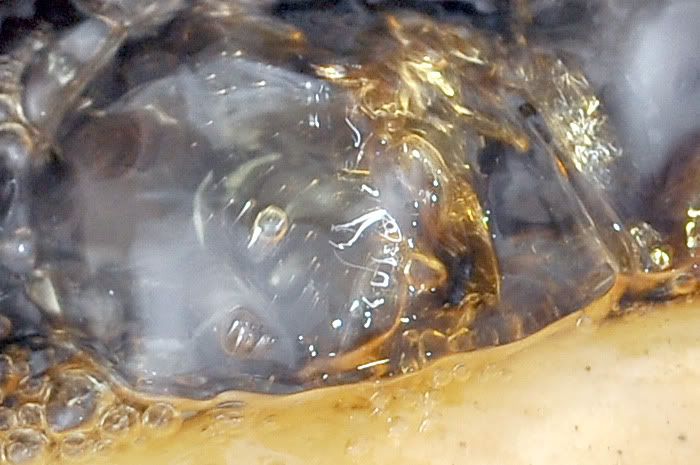ARTS ! ↕
I dun read something interesting in a book. A book!
Per Jeff Potter in
Cooking for Geeeks pg. 183, eggs that are hard boiled commercially are steamed at 7.5 PSI for ease of peeling.
This experiment tests for peeling of hard boiled eggs steamed at pressure. The pressure cooker goes to 15 PSI. It has two red lines on the pressure gauge indicating target pressures. Presuming one is max and the other the half-way point, which could be wrong, the pressure seems to build beyond the second red line. I figure if the pressure is kept at the first line then that will translate to 7.5 PSI, but I honestly have no idea, and I can't be arsed to dig out the user manual right now, which I guess shows how serious I am about ...
SCIENCES !
Three eggs were brought out straight from the refrigerator and held in a glass jar filled with hot water for as long as it took the water at the bottom of the pressure cooker to come to a roiling boil which was about 1 minute. The eggs were gently lowered onto the pressure pot's trivet, the lid clamped down, and the pressure carefully monitored for 8 complete minutes. The pressure was held at the half-way line by releasing pressure via the valve, the pressure wavered slightly between the first red line and slightly above it.
The 8 minutes steaming time was pure guess.
Ordinarily, I hold eggs in 190℉ / 88℃ for appproximately 12 minutes. That is, the water is brought to a roiling boil, which at Denver altitude is 201℉/94℃, the eggs lowered into the water and the pot removed from the burner. So the water begins to cool immediately. How far it cools depends on the size of the pot, the amount of water, the number and temperature of eggs entering the water. All that together translates to a rather broad margin of differentiation between cooking episodes. No matter what, the eggs are always a total
bitch to peel, and the result of peeling a complete mess.
Jeff Potter explains there is a dispute about proper home cooking methods for hard-boiled eggs.
1) Gradual temperature rise of eggs with water from cold to hot makes sense for uniform cooking from the outer portion of the egg to the inner portion of the egg. Apparently they taste better.
2) Shock and Awe, where cold egg go directly into boiling water which shocks the outer portion of the egg resulting in easier peeling, but uneven cooking between outer and inner portions.
So, which is valued more, better tasting or easier peeling hard boiled eggs?
Jeff makes a case for using both methods. Shock the egg in boiling water for 30 seconds and then in another pot bring the eggs up to temperature along with the water for the duration of the cooking period.
These eggs were shocked as much as possible in the pressure cooker. It does take a minute for the pressure to build up inside to 7.5 PSI. They are also shocked out of pressure by spraying the whole pot with cold water, the lid removed quickly, more quickly than by releasing the pressure via the valve, and much more quickly than allowing the pot to cool down on its own, which would amount to full minutes of further cooking.
Conclusion: Pressure cooking eggs is brilliant. Thanks for the idea Jeff Potter! One of the eggs cracked around its equator and began peeling itself, which I think is the point of the whole thing. The two uncracked eggs peeled easily and flawlessly. These were the easiest to peel hard-boiled eggs that I ever peeled, almost, except for those few that I peeled when I was a kid that virtually shot out of their crumpled shells. I've been trying to relive those precious moments ever since and this is the closest I have ever come.
Maybe more pressure would would be even better.
Also it would probably be more shocking if the eggs went in completely cold. I only warmed them out of habit of treating eggs kindly.
As to taste and texture, the eggs cannot be faulted. They were not rubbery. They were uniformly cooked. Yolks were perfect. 8 minutes was as good a guess as any. Dousing the eggs in cold water prevented the iron within the yolk from migrating to the surface of the yolk and thereby discoloring it.
Halp! A Potteralanche! Welcome Jeff Potter's Twitter and Facebook friends from around the globe. Do feel free to have a look around. Use that search up there at top ↖ to find pretty much anything.




















































